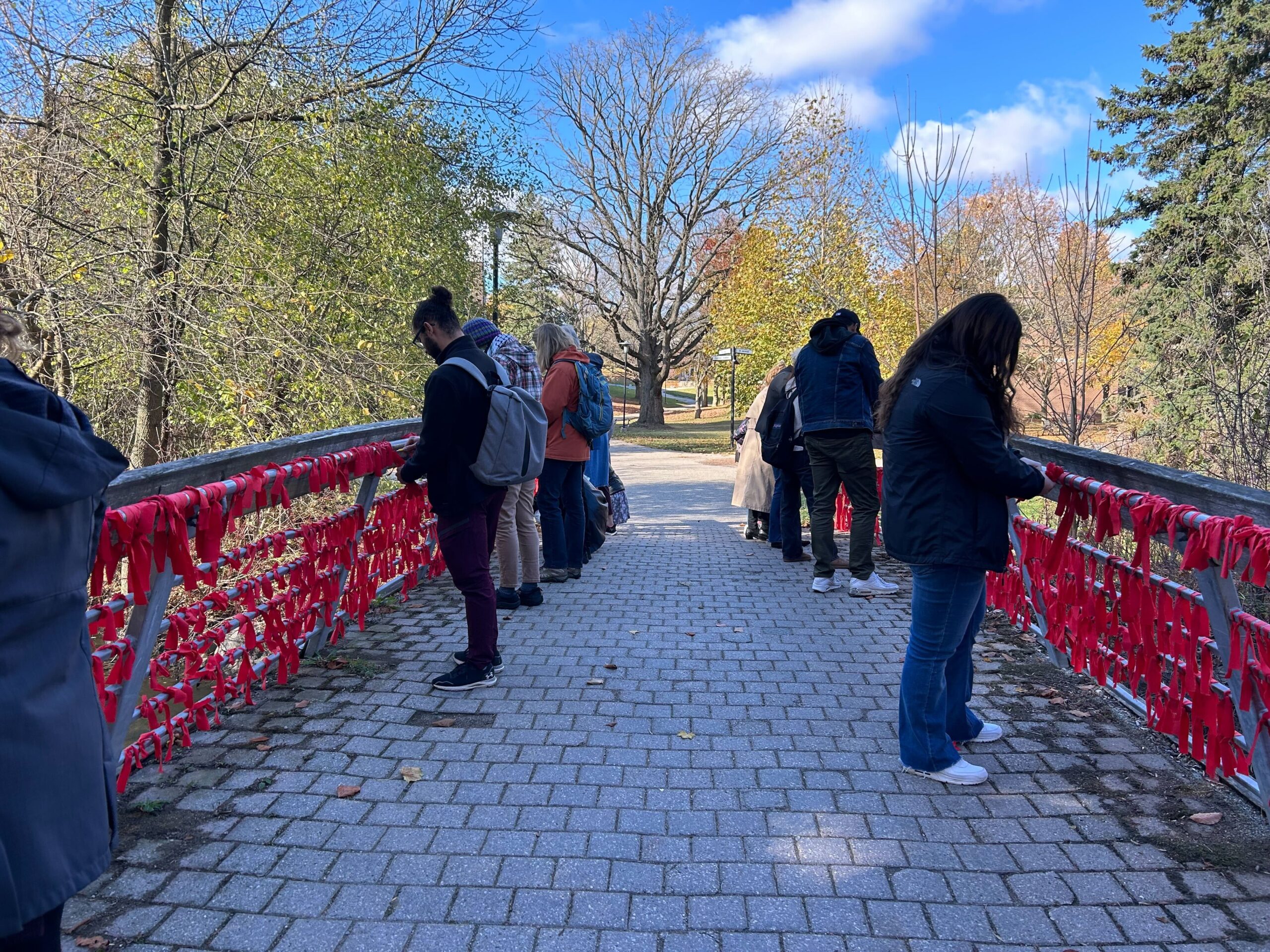Bridge installation honouring missing and murdered Indigenous women, girls and two-spirit people ended on Nov. 7 at closing ceremony
| November 8, 2024

People stand on a cobblestone bridge tying red ribbons to the railing as part of a poignant bridge installation. The scene, set in a park with trees displaying autumn foliage under a clear blue sky, honors missing and murdered Indigenous women.
People stand on a cobblestone bridge tying red ribbons to the railing as part of a poignant bridge installation. The scene, set in a park with trees displaying autumn foliage under a clear blue sky, honors missing and murdered Indigenous women.
The bridge installation on campus honouring the missing and murdered Indigenous women, girls and two-spirit people officially ended on Nov. 7 at a closing ceremony held at the Ceremonial Fire grounds by United College.
Every year, a red ribbon is tied onto the bridge between Environment 3 and United College to remember and raise awareness of the women, girls and two-spirited people in Canada who have been murdered or who are missing. The installation also aims to be a reminder that this is not just a part of Canada’s history, but is also a present and continuing issue today.
The bridge installation was brought to UW’s campus by Sorouja Moll, an associate professor here at UW, back in 2016 in its original form of writing the names of the victims on the floor with chalk.
However, the origins of this installation started during Moll’s undergraduate education at the University of Guelph during her time studying Canadian adaptations of Shakespeare. While reading an adaptation of Romeo and Juliet by Nicholas Flood Davin, Moll noticed the absence of Indigenous women’s voices in a document written by the same author.
This started Moll’s investigation into the absence of Indigenous women’s voices in Canadian society and led to her finding the statistic that there were 520 missing and murdered Indigenous women and girls in Canada. Moll found the lack of names in the statistic to be troubling and set out to identify the people that made up this number in an attempt to humanize the statistic.
“Statistics have this extraordinary power to silence and dehumanize the individuals within that. And so I thought, how can I break this open?” Moll said.
In 2008, Moll went out to the streets of Montreal and wrote all the names she found of the people within the statistic in chalk as a durational performance, calling it the ‘Writing Names Project.’
Moll highlighted the importance of how creative and performative activism helps to make passersby stop and ask questions, which encourages people to reflect on the issue more.
After bringing the ‘Writing Names Project’ to UW for the 16 Days of Activism Against Gender-Based Violence, Moll decided that the following year, the installation should change and pay homage to the Red Dress Project by Jaime Black and tie a piece of red fabric for every person on a bridge, symbolizing the connection of community on campus, instead of writing the names out with chalk.
Another change came to the installation during the COVID-19 pandemic that has continued on – the names began to be read aloud, creating a prayer-like experience that helped to bring the community together even more.
It is not just the reading of the names that has changed over the years – the installation has continued to evolve and grow each time. During the closing ceremony, the red ties are now cut and placed in a fire as a form of ceremony and this year attendees were encouraged to share why they had come, what it meant to them or what they had learnt.
Moll explained the importance of the community to educate itself and continue to engage in public discourse on the issue. “Gender-based violence is so deep, it’s so ingrained, and to disentangle ourselves to find solutions is something that needs to be worked on every single day by every single individual,” she said. “And realizing the responsibility, and thinking ‘How can I make change here?’”
Moll also highlighted how it is important that non-Indigenous people are aware that they can make change and be a part of the conversation as well, and it doesn’t just have to be up to the Indigenous community to raise awareness on these issues.
Even though the bridge installation has now come to a close for 2024, Moll impressed upon the fact that the activism, discourse, reflection and change around this topic does not end when the ties are taken off of the bridge, but will continue until there is no longer a need for people to gather and fight for this issue.
This year, 1,526 names were read aloud and red ties were placed on the bridge for two weeks. A soup lunch was held after both the opening and closing ceremonies to help encourage a greater sense of community and allow for reflection and conversation. The installation was held in collaboration with Waterloo Indigenous Student Centre and the arts faculty.
Share this story
More
Science & Tech
Waterloo alumni startup 3E8 Robotics takes autonomous delivery indoors
Emma Danesh
| January 6, 2026
Campus News, Local News
GRT transit cuts raise frustration among students and advocates
Emma Danesh
| January 5, 2026
Local News
What’s open and closed around Waterloo throughout the winter holidays?
Imprint Staff
| December 22, 2025
Campus News, Local News
City of Waterloo cracks down on unlicensed rentals, encourages tenants to know their rights
Veronica Reiner
| December 18, 2025



